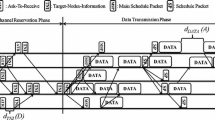Abstract
Unlike terrestrial environment, the underwater environment possess additional and complicated challenges for wireless communication. For the underwater wireless communication, traditional radio wave communication is not feasible due to high channel fading and packet loss experienced high frequency communication that also reduces the communication range. Acoustic wave communication in dynamic underwater environment naturally inherits its own limitations that include low bandwidth, slow signal propagation speed, high packet loss and short communication range. Considering the UWSNs circumstances, protocols that can counter the high packet loss and low data rate are required. The MAC protocols designed for Underwater Wireless Sensor Network (UWSN) should incorporate changes in such a way that sensor nodes can have seamless and efficient communication while minimizing the effect of imposed constraints. In this paper, we therefore propose Optimized Multi-transmission Receiver-Initiated Medium Access Control (MAC) which considers harsh, lossy, and dynamic underwater environment. Our proposed method transmits optimized number of multiple packets to increase the successful packet delivery in harsh underwater environment with low data rate.











Similar content being viewed by others
References
Bouk, S. H., Ahmed, S. H., & Kim, D. (2016). Delay tolerance in underwater wireless communications: A routing perspective. Mobile Information Systems, 2016, 6574697.
Wei, Z., Song, M., Yin, G., Wang, H., Ma, X., & Song, H. (2017). Cross deployment networking and systematic performance analysis of underwater wireless sensor networks. Sensors, 17, 1619.
Wei, Z., Song, M., Yin, G., Song, H., Wang, H., Ma, X., et al. (2017). Data access based on a guide map of the underwater wireless sensor network. Sensors, 17, 2374.
Zhang, L., Huang, J., Tang, C., & Song, H. (2017). Time reversal aided bidirectional OFDM underwater cooperative communication algorithm with the same frequency transmission. Journal of Sensors, 2017 8242369.
Climent, S., Sanchez, A., Capella, J. V., Meratnia, N., & Serrano, Juan Jose. (2014). Underwater acoustic wireless sensor networks: Advances and future trends in physical, MAC and routing layers. Sensors, 14(1), 795–833.
Moon, E., Lee, S., Yaqub, M. A., Kim, D. (2017). p-BORE: Prioritized beacon repetition and contention window selection based MAC protocol in underwater wireless sensor networks. In International conference on ubiquitous and future networks (pp. 269–271).
Stojanovic, M. (2010). On the relationship between capacity and distance in an underwater acoustic communication channel. In Proceedings of the 1st ACM international workshop on underwater networks, Los Angeles, CA, USA, 25 September (pp. 41–47).
Lurton, X. (2002). An introduction to underwater acoustics: Principles and applications. London: Springer.
Ng, H. -H., Soh, W. -S., Motani, M. (2010). ROPA: A MAC protocol for underwater acoustic networks with reverse opportunistic packet appending. In IEEE Wireless communications and networking conference (WCNC) (pp. 1–6).
Guo, X., Frater, M., & Ryan, M. (2009). Design of a propagation-delaytolerant MAC protocol for underwater acoustic sensor networks. IEEE Journal of Oceanic Engineering, 4, 170–180.
Noh, Y., Wang, P., Uichin, L., Torres, D., & Gerla, M. (2010). DOTS: A propagation delay-aware opportunistic MAC protocol for underwater sensor networks. In Proceedings of the 18th IEEE international conference on network protocols (ICNP), Kyoto, Japan, 5–8 October (pp. 183–192).
Molins, M., & Stojanovic, M. (2006). Slotted FAMA: A MAC protocol for underwater acoustic networks. In Proceedings of IEEE OCEANS.
Yackoski, J., & Shen, C. -C. (2008). UW-FLASHR: Achieving high channel utilization in a time-based acoustic MAC protocol. In ACM international conference on underwater networks and systems.
Hsu, C., Lai, K., Chou, C., & Lin, K. C. (2008). ST-MAC: spatial-temporal MAC scheduling for underwater sensor networks. In International conference on computer communications.
Kredo, K., Djukic, P., & Mohapatra, P. (2009). STUMP: Exploiting position diversity in the staggered TDMA underwater MAC protocol. In International conference on computer communications.
Casari, P., & Zorzi, M. (2011). Protocol design issues in underwater acoustic networks. Computer Communications, 34, 2013–2025.
Chirdchoo, N., Seng Soh, W., & Chua, K. (2008). RIPT: A receiver-initiated reservation-based protocol for underwater acoustic networks. IEEE Journal on Selected Areas in Communications, 26, 1744–1753.
Wen-Hwa, L., Lin, Y. -C., & Kua, S. -C. (2014). A receiver-initiated MAC protocol for underwater acoustic sensor networks. In IEEE international conference on information networking (ICOIN) (pp. 1–6).
Liao, Z., Li, D., & Chen, J. (2015). A handshake based ordered scheduling MAC protocol for underwater acoustic local area networks. International Journal of Distributed Sensor Networks, 11, 984370.
Yaqub, M. A., Raza Khan, M. T., Hassan Ahmed, S., & Kim, D. (2018). Receiver-initiated dynamic duty cycle scheduling schemes for underwater wireless sensor networks. In IEEE consumer communications and networking conference.
Sehgal, A., Tumar, I., Schnwlder, J. (2009). Variability of available capacity due to the effects of depth and temperature in the underwater acoustic communication channel. In IEEE OCEANS.
Xu, Z., Chen, C., Xu, H. (2016). Acoustic propagation properties in the seasonal change environment of shallow sea area. In Ocean acoustics (COA).
Xu, Z., Chen, C., Xu, H. (2005). The WHOI micro-modem: An acoustic communications and navigation system for multiple platforms. In IEEE oceans.
Acknowledgements
This research was supported by the Basic Science Research Program through the National Research Foundation of Korea (NRF) funded by the Ministry of Education, Science and Technology (NRF-2016R1D1A3B01015510).
Author information
Authors and Affiliations
Corresponding author
Additional information
Publisher's Note
Springer Nature remains neutral with regard to jurisdictional claims in published maps and institutional affiliations.
Rights and permissions
About this article
Cite this article
Moon, E., Khan, M.T.R., Park, H. et al. OMRI–MAC: Optimized Multi-transmission Receiver-Initiated MAC in Underwater Wireless Sensor Networks. Wireless Pers Commun 107, 1491–1505 (2019). https://doi.org/10.1007/s11277-018-5977-x
Published:
Issue Date:
DOI: https://doi.org/10.1007/s11277-018-5977-x




